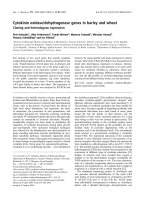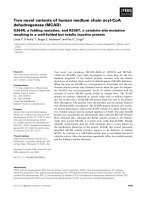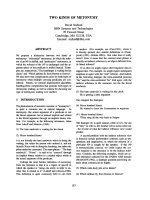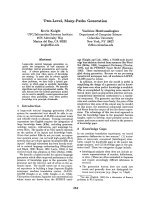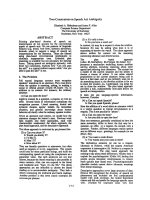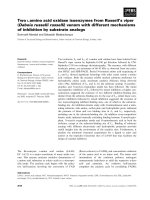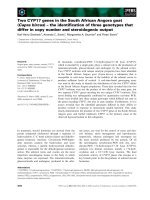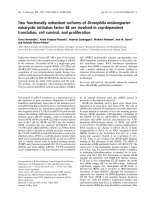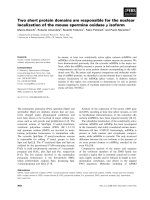Báo cáo khoa học: Two overlapping antiparallel genes encoding the iron regulator DmdR1 and the Adm proteins control sidephore and antibiotic biosynthesis in Streptomyces coelicolor A3(2) pdf
Bạn đang xem bản rút gọn của tài liệu. Xem và tải ngay bản đầy đủ của tài liệu tại đây (787.44 KB, 14 trang )
Two overlapping antiparallel genes encoding the iron
regulator DmdR1 and the Adm proteins control sidephore
and antibiotic biosynthesis in Streptomyces coelicolor
A3(2)
Sedef Tunca
1,
*, Carlos Barreiro
1
, Juan-Jose
´
R. Coque
1,2
and Juan F. Martı
´
n
1,2
1 Institute of Biotechnology of Leo
´
n, INBIOTEC, Parque Cientı
´
fico de Leo
´
n, Avenida Real no. 1, Spain
2 Area of Microbiology, Faculty of Environmental and Biological Sciences, University of Leo
´
n, Spain
Introduction
Iron is an essential nutrient that is required for many
key metabolic processes in microorganisms, such as
electron transport, energy metabolism and DNA
synthesis [1]. Recent studies have indicated that iron
metabolism in bacteria is directly connected to
oxidative stress [2,3]. Iron binding and transport by
siderophores play important roles in iron availability
in the cell [4–6]. However, the concentration of free
iron in the cells must be strictly regulated, as high
levels of free intracellular ferric iron are toxic to the
cells. In Gram-negative bacteria, iron metabolism is
controlled by the global regulatory protein Fur [7,8]
Keywords
antibiotics; desferrioxamines; iron regulation;
siderophores; Streptomyces
Correspondence
J. F. Martı
´
n, Instituto de Biotecnologı
´
a,
INBIOTEC, Parque Cientı
´
fico de Leo
´
n,
Avenida Real no. 1, 24006 Leo
´
n, Spain
Fax: +34 987 210 388
Tel: 34 987 210 308
E-mail:
*Present address
Biology Department, Faculty of Science,
Gebze Institute of Technology, Kocaeli,
Turkey
(Received 13 March 2009, revised 26 May
2009, accepted 29 June 2009)
doi:10.1111/j.1742-4658.2009.07182.x
The dmdR1 gene of Streptomyces coelicolor encodes an important regulator
of iron metabolism. An antiparallel gene (adm) homologous to a develop-
ment-regulated gene of Streptomyces aureofaciens has been found to over-
lap with dmdR1. Both proteins DmdR1 and Adm are formed in solid and
liquid cultures of S. coelicolor A3(2). The purpose of this study was to
assess possible interaction between the products of these two antiparallel
genes. Two mutants with stop codons resulting in arrested translation of
either DmdR1 or Adm were obtained by gene replacement and compared
with a deletion mutant (DdmdR1 ⁄ adm) that was defective in both genes.
The deletion mutant was unable to form either protein, did not sporulate
and lacked desferrioxamine, actinorhodin and undecylprodigiosin biosyn-
thesis; biosynthesis of these compounds was recovered by complementation
with dmdR1 ⁄ adm genes. The mutant in which formation of Adm protein
was arrested showed normal levels of DmdR1, lacked Adm and over-
produced the antibiotics undecylprodigiosin and actinorhodin (in MS
medium), suggesting that Adm plays an important role in secondary
metabolism. The mutant in which DmdR1 formation was arrested synthe-
sized desferrioxamines in a constitutive (deregulated) manner, and pro-
duced relatively normal levels of antibiotics. In conclusion, our results
suggest that there is a fine interplay of expression of these antiparallel
genes, as observed for other genes that encode lethal proteins such as the
toxin ⁄ antitoxin systems. The Adm protein seems to have a major effect on
the control of secondary metabolism, and its formation is probably tightly
controlled, as expected for a key regulator.
Abbreviations
Adm, antiparallel to DmdR; DmdR, divalent metal-dependent gene ⁄ protein; R/T, room temperature.
4814 FEBS Journal 276 (2009) 4814–4827 ª 2009 The Authors Journal compilation ª 2009 FEBS
and in Gram-positive bacteria is regulated mainly by
the DmdR (divalent metal-dependent) family of regula-
tory proteins, which includes DtxR of Corynebacte-
rium diphtheriae [9], DmdR of Corynebacterium
(Brevibacterium) lactofermentum [10], IdeR of myco-
bacteria [11] and the DmdR1 and DmdR2 proteins of
Streptomyces coelicolor [12]. After interaction with
Fe
2+
or other divalent metals, these proteins act as
transcriptional regulators, usually as repressors of
genes involved in iron metabolism. In some cases,
these iron regulators can also function as transcrip-
tional activators [7,13,14].
Streptomyces coelicolor A3(2), a well-known model
actinomycete that is able to synthesize several types of
secondary metabolites, contains two copies of the iron
regulator gene, dmdR1 and dmdR2 [12,15]. We
reported previously that disruption of dmdR1 resulted
in significant changes in the S. coelicolor A3(2) prote-
ome, particularly in enzymes related to iron metabo-
lism [12], although changes in some key glycolysis
proteins were also observed; these changes were diffi-
cult to explain at that time, unless dmdR1 plays a fur-
ther role in S. coelicolor A3(2) in addition to
controlling iron metabolism. During our studies on the
deletion mutant S. coelicolor D dmdR1 , we observed
that it was defective with respect to sporulation. Strik-
ingly, we found that the antisense strand of dmdR1
gene contains an ORF that almost fully overlaps
dmdR1 and shows 87% identity with a development-
regulated gene from Streptomyces aureofaciens [16]
(Fig. 1). This S. aureofaciens gene was found in a
search for promoters that are recognized by the RpoZ
sigma factor, a member of the WhiG family [17] of
sigma factors [18,19]. Nova
´
kova
´
et al. [16] provided
evidence showing that this (unnamed) gene is tran-
scribed in S. aureofaciens. The role of this putative
‘development’ gene is unknown, and its possible
involvement as a putative antisense regulator of
dmdR1 is intriguing, as it may modulate iron meta-
bolism and therefore expression of many other genes
in the cell.
Overlapping antiparallel genes are rare [20], and
have not been described in actinomycetes, but recent
evidence suggests that, in Escherichia coli, RNA
formed from intragenic reverse promoters may explain
the tight balance required to prevent a toxic protein
from attacking the producer cell (toxin ⁄ antitoxin sys-
tem) [21,22]. It was therefore of great interest to deter-
mine whether proteins encoded by the antiparallel
genes are translated, and to study the involvement of
dmdR1 and the antisense gene (adm) in the regulation
of S. coelicolor A(3)2 sporulation and antibiotic and
siderophore biosynthesis.
Results
The Adm protein is present in S. coelicolor
A3(2) cells grown in solid medium and in liquid
cultures
Analysis of the S. coelicolor dmdR1 gene revealed the
presence in the opposite orientation (antisense strand)
of a putative gene overlapping dmdR1 (Fig. S1). The
protein predicted to be encoded by this gene showed
87% identity at amino acid level, to that predicted to
be encoded by a gene reported in S. aureofaciens [16]
that has been named adm (antiparallel to dmdR1).
Streptomyces genes have a biased codon usage, with a
A
B
Fig. 1. Nonsense mutations introduced into the coding sequence of the dmdR1 and adm genes. (A) Organization of the ORFs in the
S. coelicolor A3(2) DNA region corresponding to the dmdR1 gene. Note the antiparallel organization of dmdR1 and adm. (B) The introduced
nonsense mutations are in bold and underlined, and indicated as STOP. The promoter regions are indicated by solid arrows. Only relevant
parts of the sequence are shown. The numbers in the sequence indicate the nucleotide positions numbered from the translation start codon
of the dmdR1 or adm gene. Note that the stop codons do not affect the amino acids encoded by the complementary strands.
S. Tunca et al. Overlapping antiparallel genes and iron regulation
FEBS Journal 276 (2009) 4814–4827 ª 2009 The Authors Journal compilation ª 2009 FEBS 4815
high GC content in the third position of the codons.
The GC content in this position was 96% for the
dmdR1 gene and 94% for the adm gene, supporting
the conclusion that both ORFs encode translated
Streptomyces genes.
Using rabbit antibodies raised against the C-terminal
region of the Adm protein, we observed significant lev-
els of Adm protein in liquid S. coelicolor A3(2) cul-
tures between 24 and 96 h in TSB medium (Fig. 2).
Adm was detected at a lower concentration in cells
grown in MS solid medium (days 1–7) using the same
antibodies at the same dilution (Fig. 2). These results
indicate that the Adm protein is more abundant in
liquid cultures, while its lower level in solid medium
may favour sporulation (see below). The formation of
Adm protein and its expression pattern support the
initial data obtained by Nova
´
kova
´
et al. [16] on tran-
scription from the adm promoter (designated PREN 40
by those authors).
The molecular mass of Adm deduced from the
SDS–PAGE gels was approximately 28 kDa, in agree-
ment with the expected size according to the ORF that
starts with the TTG proposed by Nova
´
kova
´
et al. [16].
Evidence for expression of the dmdR1 gene, resulting
in formation of the DmdR1 protein, was also obtained
(see below), confirming previous results [12].
Inactivation of the dmdR1 and/or adm genes:
phenotypic analyses
A S. coelicolor A3(2) mutant with a deletion of the
dmdR1 gene showed significant changes in the prote-
ome [12]. Deletion of an internal fragment of the
dmdR1 gene inactivated both the dmdR1 and adm open
reading frames (hereafter named DdmdR1 ⁄ adm), and
caused a deficiency in sporulation in the disrupted
mutant.
To assess the in vivo role of the dmdR1- and adm-
encoded proteins in S. coelicolor A3(2), the chromo-
somal dmdR1 and adm genes were replaced separately
with mutated dmdR1 and adm genes that cannot be
translated, as described in Experimental procedures.
These nonsense codon mutations (two stop codons in
one or the other ORF) were introduced in such a way
that the mutations preventing translation of the dmdR1
mRNA do not affect the amino acid sequence of the
protein encoded by the adm gene, and vice versa
(Fig. 1).
Among 652 recombinants tested, eight putative adm
mutants containing the two stop codons in the adm
ORF were found. Similarly, two putative dmdR1
mutants were obtained among 678 recombinants carry-
ing plasmid pSKMdmdR1 with the mutant allele with
the two stop codons in the dmdR1 ORF. The gene
replacement in each of these mutants was confirmed
by DNA sequencing. As clones with the same site-
directed mutations showed identical morphology and
growth behaviour, one of the clones for each of these
two mutations was chosen at random for further
experiments and named TAdmdR1 (strain in which
translation was arrested in the sense strand of dmdR1)
and TAadm (strain in which translation of the adm
mRNA was arrested).
To compare their morphology, sporulation and
physiological properties, strains DdmdR1 ⁄ adm,
TAdmdR1,TAadm and the parental strain S. coelicolor
A3(2) were grown on several types of solid medium
(Fig. 3). The parental strain S. coelicolor A3(2) and
the TAadm mutant sporulate normally on TBO and
MS sporulation media. However, TAdmdR1 does not
sporulate well on the same sporulation media (Fig. 3).
The deletion mutant DdmdR1 ⁄ adm showed no sporula-
tion at all on MS medium, and did not produce
pigments in any of the media tested (Fig. 3).
The TAadm strain sporulated efficiently on all spor-
ulation media tested, and produced far more pig-
mented antibiotics than the other strains on several
media (Fig. 3). These results suggest that removal of
the Adm protein stimulates sporulation and pigmented
antibiotic formation, whereas elimination of DmdR1
Fig. 2. Western blot analysis of the Adm protein using antibodies
against Adm. Samples were taken from cultures in TSB liquid med-
ium (upper panel) or MS solid medium (lower panel) at various
times. Adm*, ovalbumin-conjugated Adm peptide; M, molecular
mass markers (sizes in kDa are shown on the left). Six micrograms
of total protein were loaded in each lane except for the control
Adm* (5 lg). Note that the ovalbumin-conjugated Adm peptide
(Adm*) is larger than the Adm protein of S. coelicolor A3(2)
(28 kDa).
Overlapping antiparallel genes and iron regulation S. Tunca et al.
4816 FEBS Journal 276 (2009) 4814–4827 ª 2009 The Authors Journal compilation ª 2009 FEBS
decreases sporulation and pigmentation in solid media.
The phenotype of strains TAadm and TAdmdR1 was
partially medium-dependent, as reported for antibiotic
biosynthesis in many Streptomyces strains [26,28]. Pig-
mentation of the TAdmdR1 in R5 or TBO solid media
was still intense, in contrast to the results for MS med-
ium, in which the pigmentation was much lower.
Actinorhodin and undecylprodigiosin production in
these strains was quantified in liquid MS and R5
cultures, which supported high levels of actinorhodin
and undecylprodigiosin (Fig. 4). Growth in these media
of the three mutant strains was similar or even higher
than that of the parental strain S. coelicolor A3(2). The
deletion mutant DdmdR1 ⁄ adm does not produce
actinorhodin or undecylprodigiosin in liquid MS med-
ium (Fig. 4A–C). The same result was observed in
liquid R5 medium (Fig. 4D–F), confirming the impor-
tant role of these genes in biosynthesis of secondary
Fig. 3. Growth, formation of aerial mycelia,
sporulation and pigment formation of
various strains. Mutants TAdmdR1,
DdmdR1 ⁄ adm,TAadm and the parental
strain S. coelicolor A3(2) were grown in
TBO, MS and R5 media. Photographs were
taken after 10 days of culture from the top
(left column) or bottom of the plates (right
column). Note the intense pigmentation in
most tested media by the TAadm strain,
and the lack of pigment formation by the
DdmdR1 ⁄ adm deletion mutant. This latter
mutant forms aerial mycelia, but does not
sporulate.
S. Tunca et al. Overlapping antiparallel genes and iron regulation
FEBS Journal 276 (2009) 4814–4827 ª 2009 The Authors Journal compilation ª 2009 FEBS 4817
Fig. 4. Growth (mg dry weight per mL) and specific production (nmolÆmg
)1
dry weight) of actinorhodin and undecylprodigiosin. Liquid cul-
tures of the various strains were produced in MS (A–C) or R5 media (D–F). Vertical bars indicate standard deviation from the mean value.
Note the high levels of actinorhodin and undecylprodigiosin produced by the TAadm mutant, and the lack of production by the DdmdR1 ⁄ adm
mutant in MS medium. Undecylprodigiosin and actinorhodin were quantified spectrophotometrically using standard procedures [38].
Overlapping antiparallel genes and iron regulation S. Tunca et al.
4818 FEBS Journal 276 (2009) 4814–4827 ª 2009 The Authors Journal compilation ª 2009 FEBS
metabolites. The TAadm strains produced more unde-
cylprodigiosin (about sevenfold) and actinorhodin
(about twofold) compared with the other strains in
MS medium, and these results were consistent in
repeated experiments. This stimulation was medium-
dependent. In R5 medium, the TAadm strain also pro-
duced very high levels of undecylprodigiosin, but no
significant increase of actinorhodin compared to the
parental strain was found.
On the other hand, the strain TAdmdR1, defective
in DmdR1 translation, produced consistently less anti-
biotic than the wild-type in liquid MS medium. These
results confirmed the observations in solid medium,
supporting the conclusion that arrest of Adm forma-
tion at the translational level has a stimulatory effect
on undecylprodigiosin production, i.e. the Adm
protein appears to act as a negative regulator of the
biosynthesis of undecylprodigiosin. The opposite
behaviour of TAadm and TAdmdR1 strains regarding
production of antibiotic suggests interaction between
the actions of the Adm and DmdR1 proteins (see
below).
Lack of both DmdR1 and Adm proteins prevents
desferrioxamine production
Production of the siderophore desferrioxamine in the
mutants and wild-type strains was quantified by HPLC
analysis in the supernatants of cultures grown in mini-
mal medium alone or minimal medium supplemented
with 35 lm iron. The results of HPLC analyses showed
that strain TAadm produces desferrioxamines only in
the absence of iron, like the wild-type strain (Fig. 5A).
As expected, addition of 35 lm iron to the culture
medium completely suppressed desferrioxamine pro-
duction in the wild-type and TAadm strains. These
results prove that a functional DmdR1 represses the
formation of desferrioxamines in the presence of iron,
whereas biosynthesis of this siderophore occurs in
iron-starved cultures.
It is noteworthy that production of desferrioxamines
in the TAdmdR1 mutant was similar in the presence or
absence of iron (compare Fig. 5A,B). DmdR1 is
known to be the major iron regulator in S. coelicolor
A3(2), acting as a repressor in presence of iron
A
B
Fig. 5. HPLC analyses of the formation of
desferrioxamines B and E (labelled as DesB
and DesE) and complementation of desferri-
oxamine production. (A) Cultures of S. coeli-
color A3(2) and the TAdmdR1,TAadm and
DdmdR1 ⁄ adm mutants were produced in
minimal medium without iron supplementa-
tion (left) or minimal medium supplemented
with 35 l
M iron (right). Formation of desfer-
rioxamines is absent in the DdmdR1 ⁄ adm
mutant and is inhibited by iron addition in all
strains except in TAdmdR1, which lacks the
DmdR1 iron regulator. The chemical struc-
tures of desferrioxamines E and B are
shown in Challis [6] and Tunca et al. [23].
(B) Complementation of the DdmdR1 ⁄ adm
mutant in minimal medium without iron was
achieved by transformation with plasmids
pHZBH9 (multiple-copy) and pRAdmdR1
(single-copy) containing the dmdR1 ⁄ adm
genes. The numbers adjacent to the DesB
and DesE peaks indicate their retention
time.
S. Tunca et al. Overlapping antiparallel genes and iron regulation
FEBS Journal 276 (2009) 4814–4827 ª 2009 The Authors Journal compilation ª 2009 FEBS 4819
[6,12,15]; lack of the iron regulatory protein in the
TAdmdR1 mutant prevents iron repression, thus con-
verting this strain to a deregulated desferrioxamine
producer.
The deletion mutant DdmdR1 ⁄ adm was defective in
desferrioxamine production in the presence or absence
of iron. No desferrioxamines could be detected in cul-
tures of the deleted strain under the same conditions
used for the other strains (Fig. 5A). This result is inter-
esting and suggests an important role for Adm in iron
metabolism, in addition to that for DmdR1. As indi-
cated above, the simple absence of DmdR1 does not
prevent desferrioxamine biosynthesis, but simultaneous
lack of Adm prevents deferrioxamine formation; there-
fore, the mutant DdmdR1 ⁄ adm is defective in iron
scavenging and transport, which may explain its very
poor or null growth in some media. The Adm protein
may serve as an activator of desferrioxamine synthesis,
and the DmdR1 ⁄ Adm ‘tandem’ proteins may act as a
fine modulator system of iron regulation. As indicated
above, the DadmR1 ⁄ adm mutant does not produce ac-
tinorhodin and undecylprodigiosin, suggesting that
interaction of these two proteins plays an important
role in the control of secondary metabolism (including
production of desferrioxamines and antibiotics).
Complementation of the DdmdR1/adm mutant
restored desferrioxamine production
Complementation of the DdmdR1 ⁄ adm strain was
performed using a 9233 bp BamHI ⁄ HindIII fragment
containing dmdR1 and adjacent regions in a multicopy
pHZ1351-derived vector named pHZBH9, or using a
smaller plasmid pRAdmdR1 (constructed by cloning a
2.2 kb BclI fragment of pSKdmdR1 into a BamHI site
of the single-copy plasmid pRAKn). Kanamycin-
(pRAdmdR1) or thiostrepton- (pHZBH9) resistant
transformants carrying these plasmids were assayed for
their siderophore and antibiotic production. Comple-
mentation of the deletion in the DdmdRI-adm strain by
the wild-type gene (either one copy or multiple copies)
restored desferrioxamine production (Fig. 5B). Func-
tional complementation of the deleted mutant was the
result of either one single integrated copy of the gene
(in pRAdmdR1) or multiple copies of the original gene
(in pHZBH9). As shown in Fig. 5B, as expected, com-
plementation with the single-copy pRAdmdR1 resulted
in lower levels of desferrioxamines B and E than
complementation with the multiple-copy plasmid,
which restored production of desferrioxamines B and
E to the levels in the wild-type strain. Desferrioxam-
ines B and E are two products of the desferrioxamine
biosynthetic pathway that differ with respect to the
presence of an acetyl or succinyl group modifying the
N-hydroxycadaverine residue [23].
Complementation of the DdmdR1/adm deletion
mutant with multiple copies of dmdR1/adm
restored actinorhodin production
Complementation of the dmdR1 ⁄ adm deletion with the
multiple-copy plasmid pHZBH9 restored actinorhodin
production in TSB liquid medium and solid TSA
medium (Fig. S2); on the other hand, the single-copy
plasmid pRAdmdR1 complemented the antibiotic pro-
duction deficiency in TSB and R5 liquid media but not
in TSA solid medium. This latter plasmid contains a
smaller insert (2.2 kb including the complete dmdR1
⁄
adm genes). In order to clarify whether the lack of com-
plementation of antibiotic production in TSA solid
medium by pRAdmdR1 was due to the small insert size
or the single-copy number of the dmdR1 ⁄ adm genes, we
cloned the 2.2 kb BclI fragment (the same as in
pRAdmdR1) into the BamHI site of the multiple-copy
vector pHZ1351, to give pHZdmdR1. Multiple copies of
the 2.2 kb fragment restored actinorhodin production
in TSA solid medium, as occurred with pHZBH9 which
carries a 9.2 kb insert (Fig. S2B). Those results indicate
that the single copy of the dmdR1 ⁄ adm genes in
pRAdmdR1 was insufficient for full restoration of anti-
biotic biosynthesis in some media. Similar observations
have been made using pRA-derived plasmids in Strepto-
myces natalensis with respect to pimaricin production
(J.F. Aparicio, Institute of Biotechnology, Leon, Spain,
personal communication).
Expression of the overlapping genes: Western
blot analysis using antibodies to DmdR1 and
Adm
To determine whether the lack of translation of one
gene affected expression of the antiparallel one, western
blot analyses of formation of the DmdR1 protein were
performed for the various mutants with either deletion
or arrested translation of dmdR1 or adm. The results
showed unequivocally that mutants TAdmdR1 and
DdmdR1 ⁄ adm completely lack the DmdR1 protein,
which was partially replaced by increased formation of
the homologous protein DmdR2 (Fig. 6A,B). The lack
of DmdR1 protein formation in the TAdmdR1 mutants
correlated well with the lack of iron regulation of
desferrioxamine biosynthesis (Fig. 5A). Iron regulation
of desferrioxamine biosynthesis requires the DmdR1
protein and high levels of iron.
Experiments to assess the level of Adm protein in
the various strains confirmed that the Adm protein is
Overlapping antiparallel genes and iron regulation S. Tunca et al.
4820 FEBS Journal 276 (2009) 4814–4827 ª 2009 The Authors Journal compilation ª 2009 FEBS
indeed abundant in the wild-type strain and that it is
absent in the TAadm and DdmdR1 ⁄ adm strains, as
expected (Fig. 6C). It is noteworthy that the Adm pro-
tein levels were low in the TAdmdR1 mutant, suggest-
ing that lack of DmdR1 in this mutant reduces
synthesis of the Adm protein. A putative DmdR1-
binding sequence (iron box) has been found in the
upstream region of the adm gene, which may explain
this effect (see Discussion).
Discussion
Streptomyces species produce a plethora of secondary
metabolites, including antibiotics [24] and siderophores
[25], and undergo a complex developmental cycle.
Many factors appear to influence the onset of antibi-
otic production in actinomycetes [26]. Despite the iden-
tification and characterization of several genes that
affect antibiotic production, there is still no overall
understanding of the network that integrates the vari-
ous environmental and nutritional signals that bring
about changes in the expression of biosynthetic genes
[3,27]. Imbalances in metabolism lead to physiological
stress and influence the onset of antibiotic production
(reviewed by Bibb [26] and Martı
´
n [28]).
The intracellular level of iron in the soil-dewelling
Streptomyces species must be strictly regulated to
adjust their metabolism to the iron concentration in
diverse habitats. Numerous studies have shown that
the DtxR (DmdR) and Fur proteins are pleiotropic
regulators that control iron uptake and also other pro-
cesses related to iron metabolism, including oxidative
stress [1,2]. Camacho et al. [29] reported that, in addi-
tion to genes involved in siderophore production and
iron storage, the Mycobacterium tuberculosis DmdR
homologue, named IdeR, controls genes that encode
putative transporters, transcriptional regulators, pro-
teins involved in general metabolism, members of the
PE ⁄ PPE family of conserved mycobacterial proteins,
and the virulence determinant MmpL4. Our results
suggest that DmdR1, like IdeR and DtxR, may also
be a wide-domain regulator controlling not only iron
metabolism [12] but also other processes such as spor-
ulation, although some of these other functions may
be due to the antiparallel adm gene (see below).
The iron regulatory proteins may negatively or posi-
tively regulate transcription of various genes [7,13,14].
The results presented here indicate that DmdR1 acts
as a negative regulator of desferrioxamine biosynthesis
in the presence of iron. Lack of DmdR1 or deprivation
of iron leads to deregulated (constitutive) formation of
desferrioxamines. However, expression of adm is
required for overall function of the iron regulatory
control, as the DdmdR1 ⁄ adm mutant cannot produce
detectable levels of desferrioxamines. The Adm protein
may act as a positive regulator of desferrioxamine
A
C
B
Fig. 6. Immunodetection of DmdR1 and Adm proteins. (A,B) Western blot reactions of wild-type S. coelicolor A3(2) (lane 2) and the TAadm
(lane 3), TAdmdR1 (lane 4) and DdmdR1 ⁄ adm (lane 5) mutants. Lane 1, pure DmdR1 protein; lane 6, pure DmdR2 protein. (A) Reaction with
antibodies against DmdR1. (B) Reaction with antibodies against DmdR2. Antibodies against DmdR1 react with both DmdR1 and DmdR2, but
antibodies against DmdR2 are largely specific for DmdR2 [15]. Note the lack of DmdR1 protein in TAdmdR1 and DdmdR1 ⁄ adm strains. (C)
The central panel shows extracts of wild-type S. coelicolor A3(2) (WT) and the TAadm,TAdmdR1 and DdmdR1 ⁄ adm mutants. The left and
right panels show control reactions of Adm* (a 15 amino acid peptide coupled to ovalbumin) and pure DmdR1 revealed using antibodies
against Adm (left panel) and antibodies against DmdR1 (right panel). Note the absence of Adm protein in both TAadm and DdmdR1 ⁄ adm,
and the lower reaction intensity in TAdmdR1 strains. Six micrograms of total protein were loaded in each lane.
S. Tunca et al. Overlapping antiparallel genes and iron regulation
FEBS Journal 276 (2009) 4814–4827 ª 2009 The Authors Journal compilation ª 2009 FEBS 4821
biosynthesis, thus compensating for the negative effect
of DmdR1.
Unlike dmdR1 of S. coelicolor A3(2), which is not
essential (results presented here) [12], ideRof
M. tuberculosis is an essential gene; an ideR null
mutant cannot be generated without incorporation of
a second copy of the gene [11]. A reason for this dif-
ference is that in Streptomyces species there are two
copies (dmdR1 and dmdR2) of the dmdR gene [15],
as also shown here (Fig. 6A,B). We have confirmed
by computer searches that the genomes of Streptomy-
ces avermitilis, Streptomyces griseus, Streptomyces livi-
dans and Saccharopolyspora erythreae also contain
two copies of the iron regulator. The antiparallel
gene adm is present and overlaps with dmdR1, but
there is no similar ORF in the antisense strand of
dmdR2.
DmdR1 is known to bind to an iron box located in
the upstream region of the desABCD cluster that
encodes enzymes for desferrioxamine biosynthesis [6].
At least nine other iron boxes were identified by bioin-
formatic analyses upstream of other genes in S. coeli-
color A3(2) [12,15].
It is noteworthy that there is a significant increase in
undecylprodigiosin production in the TAadm mutant,
which lacks the Adm protein and has a normal
DmdR1 content. The Adm protein appears to act as a
negative regulator of the biosynthesis of actinorhodin
and undecylprodigiosin in MS medium cultures of
S. coelicolor A3(2). The response of the TAadm null
mutant is highly dependent on the culture medium, as
expected because of their differences in iron and phos-
phate content. This hypothesis of a strong regulatory
effect of Adm on various antibiotic pathways is consis-
tent with the lack of antibiotic and desferrioxamine
formation and the absence of sporulation in the dele-
tion DdmdR1 ⁄ adm strain. Indeed, our previous results
on the proteomics of the DdmdR1 ⁄ adm mutant showed
that several enzymes of the primary metabolism (e.g.
fructose-1,6-bisphosphate aldolase, a key glycolysis
enzyme) and iron-related pathways are over- or under-
expressed in this mutant compared to the parental
strain. It may be concluded that some of these effects
are probably due to the simultaneous disruption of
adm in the deletion mutant.
The finding that the dmdR1 gene overlaps with an
antiparallel gene (adm) that shows 87% identity with a
development-regulated gene of S. aureofaciens [16] is
really intriguing. The S. aureofaciens adm gene was
found in a search for promoters that are recognized
by the RpoZ sigma factor, a member of the WhiG
family [17,18]. Nova
´
kova
´
et al. [16] reported that the
promoter of the adm gene is induced at the time of
aerial mycelium formation and switched off in a rpoZ-
defective strain. Using high-resolution S1 mapping,
Nova
´
kova
´
et al. [16] showed that this gene is
expressed in S. aureofaciens, and identified its pro-
moter region.
An important question is whether both proteins
DmdR1 and Adm can be translated from the antipar-
allel genes. Our results show that the Adm protein is
clearly seen in liquid TSB S. coelicolor A3(2) cultures
for up to 96 h, at which time the secondary metabo-
lites have already formed. It was also detected in cells
collected from solid medium until day 7. There is very
little information on expression of antiparallel genes in
bacteria [20]. Recently, negative regulation of the
EcoRI-encoding gene by two intragenic reverse pro-
moters has been described in E. coli [22]. These intra-
genic reverse promoters are functional, and mutations
of their conserved sequences led to decreased expres-
sion of the region of the gene lying downstream of the
reverse promoter. This has been interpreted as a mech-
anism for tight control of expression of genes encoding
proteins that may be lethal, e.g. the toxin ⁄ antitoxin
proteins [21] and other so-called ‘genetic addiction’
systems [30,31].
In this work, the results of immunodetection studies
showed that both proteins DmdR1 and Adm are
formed in the wild-type strain, although their protein
levels are probably cross-influenced, as shown in the
western analysis of extracts of mutants defective in the
translation of DmdR1.These analyses confirmed that
the TAdmdR1 mutant lacks DmdR1 protein and
instead show increased levels of the ‘substitute’ ana-
logue DmdR2, as observed previously [15]. The cells
therefore tend to compensate for lack of the important
DmdR1 regulator by switching on DmdR2 as a ‘sub-
stitute’ iron regulator.
When the Adm protein levels were compared in the
various strains, it was found to be abundant in the
wild-type and less so in the TAdmdR1. The molecular
mechanism by which formation of Adm responds to
the level of DmdR1 protein is still unknown; expres-
sion of the adm gene is probably under the control of
the iron regulation mechanism, as a putative DmdR1-
binding sequence (iron box) has been found in the
upstream region of the adm gene. Alternatively, the
adm transcript may act (if not properly loaded with
ribosomes) as an antisense RNA, preventing dmdR1
mRNA translation, and vice versa.
An important question is why the TAadm strain
overproduces antibiotics. As the DmdR1 protein in
this transformant is not significantly altered with
respect to the parental wild-type (Fig. 6A,B), the dras-
tic effect on pigmentation must be due to the absence
Overlapping antiparallel genes and iron regulation S. Tunca et al.
4822 FEBS Journal 276 (2009) 4814–4827 ª 2009 The Authors Journal compilation ª 2009 FEBS
of Adm protein in this strain, i.e. Adm may act as a
negative regulator of antibiotic biosynthesis. Expres-
sion of the adm gene is known to be under the control
of the RpoZ sigma factor [16], suggesting involvement
of a sigma-factor mediated cascade in the expression
of secondary metabolites and differentiation genes.
The antiparallel adm ORF occurs in all Streptomyces
genomes known so far [32–34], but not in those of
Mycobacterium or Corynebacterium species or Sacchar-
ophlyspora erythrea [35] (Fig. S3), in good correlation
with the ability of the Streptomyces species to produce
secondary metabolites and to sporulate.
Experimental procedures
Microorganisms, plasmids and growth conditions
The bacterial strains and plasmids used in this study are
listed in Table 1. Streptomyces coelicolor A3(2) cultures
were grown in YEME medium (yeast extract 10 gÆL
)1
, malt
extract 10 gÆL
)1
) to achieve disperse growth, iron-limited
minimal medium (ILMM) [36] for siderophore production
experiments, TBO medium [37] for spore preparations, MS
solid medium [28] and TSB liquid medium or TSA solid
medium [39] for protein isolation or antibiotic production,
and R5 medium [38] for phenotypic analysis.
Streptomyces lividans 1326 was used as the host for
Streptomyces plasmid contructions. E. coli cultures were
grown in Luria–Bertani broth alone or Luria–Bertani broth
supplemented with glucose (20 mm). E. coli DH5a (Strata-
gene) was used as the host for routine plasmid construc-
tions. Ampicillin (100 lgÆmL
)1
), apramycin (50 lgÆmL
)1
),
chloramphenicol (25 lgÆmL
)1
), kanamycin (50 l g ÆmL
)1
)or
thiostrepton (50 lgÆmL
)1
in solid medium; 25 lgÆmL
)1
in
liquid medium) were added to growth media as necessary.
DNA manipulations
Isolation of plasmid and bacterial chromosomal DNA,
restriction enzyme digestions, agarose gel electrophoresis
and Southern analysis were performed according to stan-
dard molecular biology techniques [39]. Plasmids were
Table 1. Strains and plasmids used in this study.
Strain ⁄ plasmid Relevant genotype ⁄ comments Source ⁄ reference
Cosmids ⁄ plasmids
STD10 Cosmid containing the dmdR1 gene Redenbach et al.
(1996) [42]
pBluescript SK Cloning vector, ColE1 origin, Amp
r
Stratagene
pHZ1351 Highly unstable Sti+ vector, useful for
gene replacement in
Streptomyces
Kieser et al. (2000) [38]
pRA Conjugative and integrative vector
derived from pSET152
R. Pe
´
rez-Redondo
(this laboratory)
pRAKn Derivative of pRA containing the kanamycin
resistance gene (neo)
This study
pSKdmdR1 dmdR1 gene cloned into pBluescript SK This study
pSKMdmdR1 pSKdmdR1 mutated in dmdR1 gene This study
pSKMadm pSKdmdR1 mutated in adm gene This study
pHZBH9 dmdR1 gene cloned into pHZ1351 Flores et al. (2005) [12]
pHZdmdR1 dmdR1 gene cloned into pHZ1351 This study
pRAdmdR1 dmdR1 gene cloned into pRAKn This study
E. coli strains
DH5a F
)
recA1 endA2 gyrA96 thi-1 hsdR17 (r
k
)
m
k
+
)
sup44relA1k
)
(u80dlacZDM15)
D(lacZYA-argF) U169
Stratagene
ET12567 dam, dcm, hsdS, cat, tet MacNeil et al. (1992) [43]
Streptomyces strains
S. lividans 1326 Prototrophic wild-type Kieser et al. (2000) [38]
S. coelicolor A3(2) Prototrophic wild-type John Innes Institute,
Norwich, UK
S. coelicolor DdmdR1 ⁄ adm dmdR1::aac(3)IV Flores et al. (2005) [12]
S. coelicolor TAdmdR1 dmdR1 with two translational stop codons
in the sense strand
This study
S. coelicolor TAadm dmdR1 with two translational stop codons
in the antisense strand
This study
S. Tunca et al. Overlapping antiparallel genes and iron regulation
FEBS Journal 276 (2009) 4814–4827 ª 2009 The Authors Journal compilation ª 2009 FEBS 4823
transformed into E. coli strains by standard methods. Con-
jugation and transformation conditions for Streptomyces
species were as described by Kieser et al. [38]. DNA frag-
ments used as probes were labelled with digoxigenin using
a random priming kit (DIG DNA labelling mix; Roche
Diagnostics GmbH, Mannheim, Germany).
Mutant construction by site-directed
mutagenesis
Oligonucleotide-directed site-specific mutagenesis was per-
formed using a Quikchange site-directed mutagenesis kit
(Stratagene, La Jolla, CA, USA). This method uses comple-
mentary oligonucleotides encoding the desired mutation.
The oligonucleotides used in the mutagenesis reactions are
listed in Table 2. A 7950 bp NotI fragment of cosmid
STD10 containing the complete coding region of dmdR1
and adjacent regions was cloned into pBluescript SK NotI
site to generate pSKdmdR1 (10 911 bp), which was then
used for site-directed mutagenesis experiments.
To prevent translation of each strand, two in-frame
translational stop codons were introduced into the sense or
antisense strands of plasmid pSKdmdR1 by site-directed
mutagenesis. These mutations were introduced in such a
way that mutations causing translational stop of one gene
do not affect the amino acids encoded by the overlapping
gene in the complementary strand (Fig. 1). The plasmids
with the mutations in adm and dmdR1 genes were named
pSKMadm and pSKMdmdR1, respectively. After mutagene-
sis, the apramycin-resistance cassette with oriT region
(1398 bp EcoRI ⁄ HindIII fragment) from pIJ773 was cloned
into both pSKMadm and pSKMdmdR1. The plasmids car-
rying the apramycin-resistance cassette (12 309 bp) were
introduced into non-methylating E. coli ET12567 contain-
ing the RP4 derivative pUZ8002 plasmid. Then, the plas-
mids for gene replacement were transferred to S. coelicolor
A3(2) by intergeneric conjugation [38]. Apramycin-resistant
colonies (single crossovers) were selected, and passed
through five rounds of non-selective cultivation in YEME
to facilitate the second crossover. Then the apramycin-
sensitive recombinants were screened to identify dmdR1-
and adm-inactive strains.
DNA sequencing
The mutated region was amplified from the DNA of puta-
tive dmdR1 and adm mutants by PCR using oligonucleo-
tides 5¢-TGTACCTCCGCACCATCCTC-3¢ and 5¢-CCTCG
CACGCGAATCGCCC-3¢. The nucleotide sequence of the
PCR fragments was determined by the dideoxynucleotide
chain termination method using a BigDye Terminator cycle
sequencing kit (Applied Biosystems, Carlsbad, CA, USA).
Complementation of DdmdR1 ⁄ adm
The DdmdR1 ⁄ adm null mutant was constructed previously
[12] by deleting a fragment of the dmdR1 gene and replac-
ing it by the apramycin resistance gene (aac(3)IV). Com-
plementations were performed using pHZBH9 carrying a
9233 bp BamHI ⁄ HindIII fragment containing dmdR1 and
adjacent regions in a pHZ1351 replicon [12], and with the
new constructs pRAdmdR1 and pHZdmdR1.
pRAdmdR1 and pHZdmdR1 were constructed by cloning
a 2.2 kb BclI fragment of pSKdmdR1 into the BamHI sites
of pRAKn (6637 bp) and pHZ1351 [38], respectively. The
three plasmids pHZBH9, pRAdmdR1 and pHZdmdR1 were
amplified in E. coli 12567 and used to transform S. coelicolor
DdmdR1 ⁄ adm protoplasts [38]. Kanamycin- (pRAdmdR1)
and thiostrepton (pHZBH9, pHZdmdR1)-resistant colonies
were selected and assayed for siderophore and antibiotic
production.
Assays of actinorhodin and undecylprodigiosin
Undecylprodigiosin and actinorhodin production were
measured as described by Kieser et al. [38].
Analysis of siderophores
Streptomyces strains were cultured in iron-limited minimal
medium ILMM [36], distributed into 500 mL flasks treated
with 10% nitric acid and autoclaved. CaCl
2
Æ2H
2
O (0.01%
final concentration) and glucose (0.25% final concentration;
autoclaved separately) and filter-sterilized yeast extract
(0.005% final concentration) were then added to the culture
flasks. The same medium supplemented with FeSO
4
Æ7H
2
O
(35 lm final concentration) was used as a control. Cultures
were grown in 500 mL flasks on a rotary shaker (250 rpm)
at 30 °C. The cells were removed by filtration and the cul-
ture supernatant (50 mL) was freeze-dried. The residue was
re-dissolved in 1 mL of distilled water; after centrifugation
at 13 000 g for 5 min at R/T, the supernatant was mixed
with 15 lLofa1m FeCl
3
solution to form tris-hydroxa-
mate-Fe
3+
complexes. Insoluble particles were removed by
Table 2. Oligonucleotides used in the mutagenesis reactions. The
nucleotides causing the mutations are underlined and in bold.
Name Sequence (5¢-to3¢)
spo-1F GGACACCGCCTC
TCACGTGTTCGTCG
spo-1R CGACGAACACGTG
AGAGGCGGTGTCC
spo-2F CGGGCCGGGGT
TCAGCCCGGCTCG
spo-2R CGAGCCGGGCTG
AACCCCGGCCCG
dmdR1-1F CCGAGTCGCCGTA
GGGCAACCCGATC
dmdR1-1R GATCGGGTTGCC
CTACGGCGACTCGG
dmdR1-2F GCAGCTGATGTA
GACGCTGCGCCGG
dmdR1-2R CCGGCGCAGCGT
CTACATCAGCTGC
Overlapping antiparallel genes and iron regulation S. Tunca et al.
4824 FEBS Journal 276 (2009) 4814–4827 ª 2009 The Authors Journal compilation ª 2009 FEBS
centrifugation at 13 000 g for 5 min at R/T, and the solu-
tion was filtered using a Vivaspin concentrator (Sartorius
AG, Goettingen, Germany) prior to HPLC analysis.
HPLC separation of siderophores was performed in a
reverse-phase column (Nucleosil C18, particle size 5 lm,
internal diameter 4.6 mm, length 150 mm, Scharlau Science,
Barcelona, Spain). A solution of 0.1% aqueous formic
acid ⁄ methanol (1 mLÆmin
)1
flow rate) was used as a solvent
system. The tris-hydroxamate-Fe
3+
complexes were detected
at a wavelength of 435 nm. Samples of pure desferrioxamines
B and E, provided by G. Challis (Department of Chemistry,
University of Warwick, Coventry, UK), were used as
standard.
Western blot analysis
S. coelicolor A3(2) protein extracts were prepared from 24 h
cultures in liquid or solid media as described in Results.
Aliquots (25 mL) of bacterial cultures were harvested by cen-
trifugation at 5500 g for 10 min. Cell pellets were washed
twice in 25 mL of cold 0.9% NaCl, and stored at )80 °C.
Cell pellets were dissolved in washing buffer (50 mm
Tris ⁄ HCl, pH 7.2) containing CompleteÔ protease inhibitor
mixture (Roche), and added to a FastProtein BLUE tube
(BIO 101, Vista, CA, USA) containing a silica ⁄ ceramic
matrix. Cell disruption was performed as described previ-
ously [40] in a Fastprep (BIO 101) machine at a speed ratio
of 6.5 for three time intervals of 30 s each. Cell debris was
removed by centrifugation at 14 000 g for 30 min. Protein
quantification was performed using the Bradford method,
and SDS–PAGE was performed by standard Laemmli
methods using 6 lg per sample.
For immunodetection, the proteins resolved by SDS–
PAGE were blotted onto Immobilon polyvinylidene
fluoride membranes (Millipore, Billerica, MA, USA). The
membrane was incubated with primary antibodies against
Adm, DmdR1 or DmdR2 for 2 h, and then with alkaline
phosphatase-conjugated antibodies for an additional 2 h.
The immunodetected proteins were revealed using 4-nitro-
blue tetrazolium chloride and 5-bromo-4-chloro-3-indolyl-
phosphate using standard procedures (Roche).
Antibodies against Adm, DmdR1 and DmdR2
Antibodies against DmdR1 and DmdR2 were obtained as
described previously [15]. Antibodies against a 15 amino
acid peptide of the C-terminal region of Adm (Cys169 to
Arg183) were raised by injecting this peptide coupled to
ovalbumin into New Zealand white rabbits using the proto-
col described by Dunbar and Schwoebel [41]. The ovalbu-
min-coupled Adm peptide was synthesized by NeoMPS
S.A. (Strasbourg, France). Experiments were carried out in
accordance with the Guidelines of the European Union
Council (86/609/EU), following Spanish regulations (BOE
67/8509-12, 1988) for the use of laboratory animals, and
were approved by the Scientific Committee of the Univer-
sity of Leo
´
n. All efforts were made to minimize animal
suffering and to reduce the number of animals used.
Acknowledgements
This work was supported by grants from the Comisio
´
n
Asesora de Investigacio
´
n Cientı
´
fica y Te
´
cnica (BIO2006-
14853-C02-01 and GEN2003-20245-C09-01) and from
the European Union (Project Actinogen). We thank
F. Flores (University of Leon, Spain) for providing the
antibodies against DmdR1 and DmdR2, G. Challis
for samples of desferrioxamines B and E, and B. Martin,
J. Merino, A. Casenave and B. Aguado (INBIOTEC,
Leon, Spain) for excellent technical assistance.
References
1 Hantke K (2001) Iron and metal regulation in bacteria.
Curr Opin Microbiol 4, 172–177.
2 Touati D (2000) Iron and oxidative stress in bacteria.
Arch Biochem Biophys 373, 1–6.
3 Rodrı
´
guez-Garcı
´
a A, Barreiro C, Santos-Beneit F, Sola-
Landa A & Martı
´
n JF (2007) Genome-wide transcrip-
tomic and proteomic analysis of the primary response
to phosphate limitation in Streptomyces coelicolor M145
and in a DphoP mutant. Proteomics 7, 2410–2429.
4 Crosa JH (1987) Signal transduction and transcriptional
and post-transcriptional control or iron-regulated genes
in bacteria. Microbiol Mol Biol Rev 61, 319–336.
5 Neilands JB (1995) Siderophores: structure and function
of microbial iron-transport compounds. J Biol Chem
270, 26723–26726.
6 Tunca S, Barreiro C, Sola-Landa A, Coque JJ &
Martı
´
n JF (2007) Transcriptional regulation of the des-
ferrioxamine gene cluster of Streptomyces coelicolor is
mediated by binding of DmdR1 to an iron box in the
promoter of the desA gene. FEBS J 274, 1110–1122.
7 Delany I, Rappuoli R & Scarlato V (2004) Fur func-
tions as an activator and repressor of putative virulence
genes in Neisseria meningitides. Mol Microbiol 52, 1081–
1090.
8 Escolar L, Perez-Martı
´
n J & de Lorenzo V (1999)
Opening the iron box: transcriptional metalloregulation
by the Fur protein. J Bacteriol 181, 6223–6229.
9 Schmitt MP & Holmes RK (1991) Iron-dependent regu-
lation of diphtheria toxin and siderophore expression
by the cloned Corynebacterium diphtheriae repressor
gene dtxRinC. diphtheriae C7 strains. Infect Immun 59,
1899–1904.
10 Oguiza JA, Marcos AT, Malumbres M & Martı
´
nJF
(1996) The galE gene encoding the UDP-galactose
4-epimerase of Brevibacterium lactofermentum is coupled
transcriptionally to the dmdR gene. Gene 177, 103–107.
S. Tunca et al. Overlapping antiparallel genes and iron regulation
FEBS Journal 276 (2009) 4814–4827 ª 2009 The Authors Journal compilation ª 2009 FEBS 4825
11 Rodrı
´
guez GM, Voskuil MI, Gold B, Schoolnik GK &
Smith I (2002) ideR, an essential gene in Mycobacte-
rium tuberculosis: role of IdeR in iron-dependent gene
expression, iron metabolism, and oxidative stress
response. Infect Immun 70 , 3371–3381.
12 Flores FJ, Barreiro C, Coque JJR & Martı
´
n JF (2005)
Functional analysis of two divalent metal-dependent
regulatory genes dmdR1 and dmdR2 in Streptomy-
ces coelicolor and proteome changes in the deletion
mutants. FEBS J 272, 725–735.
13 Rodrı
´
guez GM & Smith I (2003) Mechanisms of iron
regulation in mycobacteria: role in physiology and viru-
lence. Mol Microbiol 47, 1485–1494.
14 Wennerhold J & Bott M (2006) The DtxR regulon of
Corynebacterium glutamicum. J Bacteriol 188, 2907–
2918.
15 Flores FJ & Martı
´
n JF (2004) Iron-regulatory proteins
DmdR1 and DmdR2 of Streptomyces coelicolor form
two different DNA–protein complexes with iron boxes.
Biochem J 379, 1–7.
16 Nova
´
kova
´
R, S
ˇ
evc
ˇ
ı
´
kova
´
B & Kormanec J (1998) A
method for the identification of promoters recognized
by RNA polymerase containing a particular sigma
factor: cloning of a developmentally regulated promoter
and corresponding gene directed by the Streptomy-
ces aureofaciens sigma factor RpoZ. Gene 208, 43–50.
17 Catakli S, Andrieux A, Decaris B & Dary A (2005)
Sigma factor WhiG and its regulation constitute a
target of a mutational phenomenon occurring during
aerial mycelium growth in Streptomyces ambofaciens
ATCC23877. Res Microbiol 156, 328–340.
18 Buttner MJ (1989) RNA polymerase heterogeneity in
Streptomyces coelicolor A3(2). Mol Microbiol 3, 1653–
1659.
19 Kormanec J (2001) Analyzing the developmental
expression of sigma factors with S1-nuclease mapping.
Methods Mol Biol 160, 481–494.
20 Callen BP, Shearwin KE & Egan JB (2004) Transcrip-
tional interference between convergent promoters
caused by elongation over the promoter. Mol Cell 14,
647–656.
21 Gerdes K, Gultyaev AP, Franch T, Pedersen K &
Mikkelsen ND (1997) Antisense RNA-regulated
programmed cell death. Annu Rev Genet
31, 1–31.
22 Liu Y & Kobayashi I (2007) Negative regulation of the
EcoRI restriction enzyme gene is associated with intra-
genic reverse promoters. J Bacteriol 189, 6928–6935.
23 Challis G (2005) A widely distributed bacterial pathway
for siderophore biosynthesis independent of nonriboso-
mal peptide synthetases. Chembiochem, 6, 601–611.
24 Berdy J (2005) Bioactive microbial metabolites. J Anti-
biot 58, 1–26.
25 Imbert M, Be
´
chet M & Blondeau R (1995) Comparison
of the main siderophores produced by some species of
Streptomyces. Curr Microbiol 31, 129–133.
26 Bibb M (1996) The regulation of antibiotic production
in Streptomyces coelicolor A3(2). Microbiology 142,
1335–1344.
27 Chater K & Bibb M (1997) Regulation of bacterial anti-
biotic production. In Biotechnology: Products of Second-
ary Metabolism, Vol. 7 (Kleinkauf H & von Dohren H,
eds), pp. 57–105. VCH, Weinheim, Germany.
28 Martı
´
n JF (2004) Phosphate control of the biosynthesis
of antibiotics and other secondary metabolites is medi-
ated by the PhoR–PhoP system: an unfinished story.
J Bacteriol 186, 5197–5201.
29 Camacho LR, Ensergueix D, Perez E, Gicquel B &
Guilhot C (1999) Identification of a virulence gene
cluster of Mycobacterium tuberculosis by signature-
tagged transposon mutagenesis. Mol Microbiol 34,
257–267.
30 Kobayashi I (2004) Genetic addiction: a principle in
symbiosis of genes in a genome. In Plasmid Biology
(Funnel BE & Phillips GJ, eds), pp. 105–144. ASM
Press, Washington DC.
31 Magnuson R & Yarmolinsky MB (1998) Corepression
of the P1 addiction operon by Phd and Doc. J Bacteriol
180, 6342–6351.
32 Omura S, Ikeda H, Ishikawa J, Hanamoto A,
Takahashi C, Shinose M, Takahashi Y, Horikawa H,
Nakazawa H, Osonoe T et al. (2001) Genome
sequence of an industrial microorganism Strepto-
myces avermitilis: deducing the ability of producing
secondary metabolites. Proc Natl Acad Sci USA 98,
12215–12220.
33 Bentley SD, Chater KF, Cerden
˜
o-Tarraga AM, Challis
GL, Thomson NR, James KD, Harris DE, Quail MA,
Kieser H, Harper D et al. (2002) Complete genome
sequence of the model actinomycete Streptomyces coeli-
color A3(2). Nature 417, 141–147.
34 Ohnishi Y, Ishikawa J, Hara H, Suzuki H, Ikenoya M,
Ikeda H, Yamashita A, Hattori M & Horinouchi S
(2008) The genome sequence of the streptomycin-pro-
ducing microorganism Streptomyces griseus IFO 13350.
J Bacteriol 190, 4050–4060.
35 Oliynyk M, Samborskyy M, Lester JB, Mironenko T,
Scott N, Dickens S, Haydock SF & Leadlay PF (2007)
Complete genome sequence of the erythromycin-pro-
ducing bacterium Saccharopolyspora erythraea
NRRL23338. Nat Biotechnol 25, 447–453.
36 Muller G & Raymond KN (1984) Specificity and mech-
anism of ferrioxamine-mediated iron transport in Strep-
tomyces pilosus. J Bacteriol 160, 304–312.
37 Higgens CE, Hamill RL, Sands TH, Hoehn MM &
Davis NE (1974) The occurrence of deacetoxycephalo-
sporin C in fungi and streptomycetes. J Antibiot 27,
298–300.
38 Kieser T, Bibb MJ, Buttner MJ, Chater KF &
Hopwood DA (2000) Practical Streptomyces Genetics.
John Innes Foundation, Norwich, UK.
Overlapping antiparallel genes and iron regulation S. Tunca et al.
4826 FEBS Journal 276 (2009) 4814–4827 ª 2009 The Authors Journal compilation ª 2009 FEBS
39 Sambrook J & Russell DW (2001) Molecular Cloning:
A Laboratory Manual. Cold Spring Harbor Laboratory
Press, Cold Spring Harbor, NY.
40 Barreiro C, Gonza
´
lez-Lavado E, Brand S, Tauch A &
Martı
´
n JF (2005) Heat-shock proteome analysis of
wild-type Corynebacterium glutamicum ATCC 13032
and a spontaneous mutant lacking groEL1, a dispens-
able chaperone. J Bacteriol 187, 884–889.
41 Dunbar BS & Schwoebel ED (1990) Preparation of
polyclonal antibodies. Methods Enzymol 182, 663–670.
42 Redenbach M, Kieser HM, Denapaite D, Eichner A,
Cullum J, Kinashi H & Hopwood DA (1996) A set of
ordered cosmids and a detailed genetic and physical
map for the 8 Mb Streptomyces coelicolor A3(2)
chromosome. Mol Microbiol 21, 77–96.
43 MacNeil DJ, Gewain KM, Ruby CL, Dezeny G,
Gibbons PH & MacNeil T (1992) Analysis of
Streptomyces avermitilis genes required for avermectin
biosynthesis utilizing a novel integration vector. Gene
111, 61–68.
Supporting information
The following supplementary material is available:
Fig. S1. Open reading frames of the dmdR1 and adm
genes.
Fig. S2. Complementation of production of pigments
by the deletion mutant DdmdR1 ⁄ adm using either
pHZBH9 or pHZdmdR1.
Fig. S3. Multiple alignments of the Adm proteins.
This supplementary material can be found in the
online article.
Please note: As a service to our authors and readers,
this journal provides supporting information supplied
by the authors. Such materials are peer-reviewed and
may be re-organized for online delivery, but are not
copy-edited or typeset. Technical support issues arising
from supporting information (other than missing files)
should be addressed to the authors.
S. Tunca et al. Overlapping antiparallel genes and iron regulation
FEBS Journal 276 (2009) 4814–4827 ª 2009 The Authors Journal compilation ª 2009 FEBS 4827
